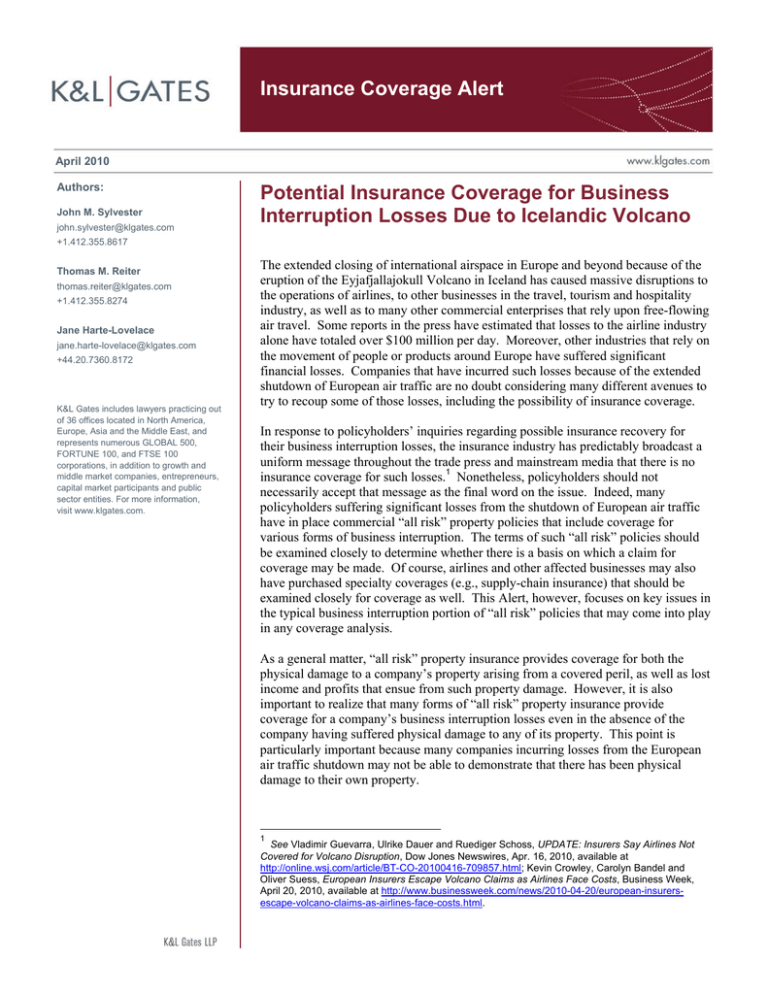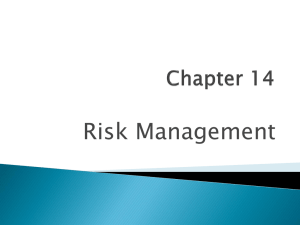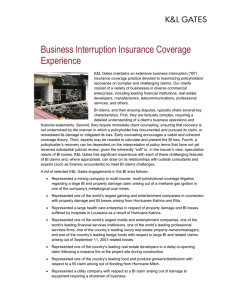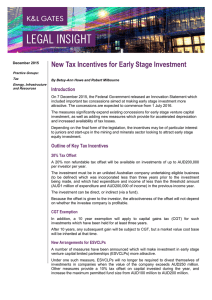
Insurance Coverage Alert
April 2010
Authors:
John M. Sylvester
john.sylvester@klgates.com
Potential Insurance Coverage for Business
Interruption Losses Due to Icelandic Volcano
+1.412.355.8617
Thomas M. Reiter
thomas.reiter@klgates.com
+1.412.355.8274
Jane Harte-Lovelace
jane.harte-lovelace@klgates.com
+44.20.7360.8172
K&L Gates includes lawyers practicing out
of 36 offices located in North America,
Europe, Asia and the Middle East, and
represents numerous GLOBAL 500,
FORTUNE 100, and FTSE 100
corporations, in addition to growth and
middle market companies, entrepreneurs,
capital market participants and public
sector entities. For more information,
visit www.klgates.com.
The extended closing of international airspace in Europe and beyond because of the
eruption of the Eyjafjallajokull Volcano in Iceland has caused massive disruptions to
the operations of airlines, to other businesses in the travel, tourism and hospitality
industry, as well as to many other commercial enterprises that rely upon free-flowing
air travel. Some reports in the press have estimated that losses to the airline industry
alone have totaled over $100 million per day. Moreover, other industries that rely on
the movement of people or products around Europe have suffered significant
financial losses. Companies that have incurred such losses because of the extended
shutdown of European air traffic are no doubt considering many different avenues to
try to recoup some of those losses, including the possibility of insurance coverage.
In response to policyholders’ inquiries regarding possible insurance recovery for
their business interruption losses, the insurance industry has predictably broadcast a
uniform message throughout the trade press and mainstream media that there is no
insurance coverage for such losses.1 Nonetheless, policyholders should not
necessarily accept that message as the final word on the issue. Indeed, many
policyholders suffering significant losses from the shutdown of European air traffic
have in place commercial “all risk” property policies that include coverage for
various forms of business interruption. The terms of such “all risk” policies should
be examined closely to determine whether there is a basis on which a claim for
coverage may be made. Of course, airlines and other affected businesses may also
have purchased specialty coverages (e.g., supply-chain insurance) that should be
examined closely for coverage as well. This Alert, however, focuses on key issues in
the typical business interruption portion of “all risk” policies that may come into play
in any coverage analysis.
As a general matter, “all risk” property insurance provides coverage for both the
physical damage to a company’s property arising from a covered peril, as well as lost
income and profits that ensue from such property damage. However, it is also
important to realize that many forms of “all risk” property insurance provide
coverage for a company’s business interruption losses even in the absence of the
company having suffered physical damage to any of its property. This point is
particularly important because many companies incurring losses from the European
air traffic shutdown may not be able to demonstrate that there has been physical
damage to their own property.
1
See Vladimir Guevarra, Ulrike Dauer and Ruediger Schoss, UPDATE: Insurers Say Airlines Not
Covered for Volcano Disruption, Dow Jones Newswires, Apr. 16, 2010, available at
http://online.wsj.com/article/BT-CO-20100416-709857.html; Kevin Crowley, Carolyn Bandel and
Oliver Suess, European Insurers Escape Volcano Claims as Airlines Face Costs, Business Week,
April 20, 2010, available at http://www.businessweek.com/news/2010-04-20/european-insurersescape-volcano-claims-as-airlines-face-costs.html.
Insurance Coverage Alert
Indeed, some “all risk” insurance policies may
specifically provide coverage for:
Business interruption losses caused by the
actions of governmental authorities preventing
or limiting access to facilities necessary for
business operations.
Business interruption losses caused by physical
damage to the property of third parties of
business partners, such as suppliers of goods and
services.
The cost of preventative measures against
threatened and imminent physical damage to a
business’s property, even if the physical damage
does not ultimately occur.
Property insurance wordings vary significantly
regarding the extent of insurance protection afforded
for these and other types of losses. A careful review
of property insurance policies will be an important
component of a company’s efforts to mitigate losses
incurred as a result of the European air traffic
shutdown.
“contingent business interruption” coverage,
which may cover the insured with respect to
certain economic losses, including lost profits,
as a result of physical damage to property of a
supplier, a customer or some other business
partner or entity;
“civil authority” coverage, which may provide
coverage for losses arising from an order of a
governmental authority, which interferes with
normal business operations;
“ingress and egress” coverage, which may
cover the insured for lost profits when access to
a business premises is blocked for a period of
time by a property damage event;
“sue and labor” coverage, which may provide
coverage for preventive costs incurred to
mitigate or limit threatened and imminent
damage to the insured’s property, even if the
physical damage ultimately does not occur;
“extra expense” coverage, which may cover
the insured for certain extra expenses incurred
to minimize the disruption of normal operations
and/or to mitigate its losses; and
“claim preparation” coverage, which may
cover the insured for the costs incurred in
compiling and presenting a claim.
Key Aspects of “All Risk” Insurance
Policies
As stated previously, the most common source of
available insurance coverage for losses from the
shutdown of European airspace is likely to be firstparty property insurance coverage, typically in the
form of broadly worded “all risk” policies.
Evaluation of the specific policy wording is critical
because, in many instances, this insurance is
supplemented by ancillary coverages or extensions
applicable to specific situations. Such all risk
property insurance policies may include the
following key aspects:
“property damage” coverage with respect to
any property that qualifies as “insured
property,” which often is broadly defined by the
policy or applicable law, including property
owned, leased, or for which the insured business
is legally responsible;
“business interruption” coverage, which may
cover the insured’s lost profits resulting from
damage to the business operations caused by an
insured peril;
Presenting a Claim
Most policies purport to identify specific
procedures that must be followed in presenting a
claim (e.g., notice, proof of loss, suit limitation) and
some of these provisions may incorporate time
deadlines and other requirements. Failure to
comply with these time-sensitive procedural
requirements, insurers will argue, may invalidate an
otherwise covered claim. Thus, careful advance
attention to these potential requirements is
recommended. In addition, because insurers often
request detailed proof of claimed losses, affected
policyholders would be well served to keep
comprehensive records of lost income and extra
expenses that have been incurred as a result of the
disruption of European air service, and to maintain
adequate supporting documentation.
April 2010
2
Insurance Coverage Alert
Common Insurer Responses and
Potential Coverage Issues
The availability of coverage may turn on a number
of policy provisions or insurer defenses, including
the following issues:
Did the policyholder’s alleged loss of income
or extra expense arise out of damage to
“insured property”? Under traditional
business interruption coverage, it is typically
necessary that relevant property damage occurs
to property owned or leased by the policyholder
(or for which the policyholder is legally liable),
but that requirement does not necessarily apply
to all coverages insuring against interruptions of
business operations. For example, there may be
governmental or regulatory actions that restrict
the use of public facilities that are necessary for
business operations to proceed, such as airports
or flight paths in the sky. In addition, many
policies provide “contingent business
interruption” coverages, which may allow a
recovery where a supplier of essential goods or
services incurs property damage, resulting in
that supplier’s inability to carry on its business
activity and thereby causing that supplier’s
customers to suffer lost business income.
Did an “interruption” of business actually
result? First-party property policies vary
significantly in their threshold requirements for
compensable business interruptions. Some
insurers may take a narrow view of what
qualifies as an “interruption” – for example, that
the business’s entire operations must shut down.
How long is the applicable “period of
restoration”? Policies sometimes include
provisions specifying that the policy will only
cover loss of income and related expenses for a
specified period of time after an insured event
occurs.
Was there a “make up” of lost business
income? Insurers often seek to determine if
lost income during the period of business
interruption has been recouped through
increased sales and profits in subsequent
periods.
What are the applicable
deductibles/retentions or “waiting periods”?
Some policies have language providing that
time element coverages only allow coverage
after a certain dollar threshold or a certain
period of time has expired. The application of
these policy features may have a significant
impact on the amount of the policyholder’s
potential recovery. Likewise, issues could
conceivably arise regarding the applicable
“number of occurrences,” i.e., whether all
damages/losses stemming from the shutdown of
European airspace should be deemed a single
occurrence, or whether separate damage events
should be deemed separate occurrences.
Conclusion
The strength of a policyholder’s coverage claim,
and the validity of any defenses or limitations to
coverage raised by insurers, will vary depending on
the specific policy wording at issue and the
applicable state law. Companies adversely affected
by the recent shutdown of European airspace due to
the Icelandic volcanic activity may wish to carefully
review their “all risk” insurance policies, as well as
any other potentially applicable insurance policies,
to determine if such policies may afford protection
for losses that they have incurred.
Anchorage Austin Beijing Berlin Boston Charlotte Chicago Dallas Dubai Fort Worth Frankfurt Harrisburg Hong Kong London
Los Angeles Miami Moscow Newark New York Orange County Palo Alto Paris Pittsburgh Portland Raleigh Research Triangle Park
San Diego San Francisco Seattle Shanghai Singapore Spokane/Coeur d’Alene Taipei Tokyo Warsaw
Washington, D.C.
K&L Gates includes lawyers practicing out of 36 offices located in North America, Europe, Asia and the Middle East, and represents numerous
GLOBAL 500, FORTUNE 100, and FTSE 100 corporations, in addition to growth and middle market companies, entrepreneurs, capital market
participants and public sector entities. For more information, visit www.klgates.com.
K&L Gates is comprised of multiple affiliated entities: a limited liability partnership with the full name K&L Gates LLP qualified in Delaware and
maintaining offices throughout the United States, in Berlin and Frankfurt, Germany, in Beijing (K&L Gates LLP Beijing Representative Office), in
April 2010
3
Insurance Coverage Alert
Dubai, U.A.E., in Shanghai (K&L Gates LLP Shanghai Representative Office), in Tokyo, and in Singapore; a limited liability partnership (also named
K&L Gates LLP) incorporated in England and maintaining offices in London and Paris; a Taiwan general partnership (K&L Gates) maintaining an
office in Taipei; a Hong Kong general partnership (K&L Gates, Solicitors) maintaining an office in Hong Kong; a Polish limited partnership (K&L
Gates Jamka sp. k.) maintaining an office in Warsaw; and a Delaware limited liability company (K&L Gates Holdings, LLC) maintaining an office in
Moscow. K&L Gates maintains appropriate registrations in the jurisdictions in which its offices are located. A list of the partners or members in each
entity is available for inspection at any K&L Gates office.
This publication is for informational purposes and does not contain or convey legal advice. The information herein should not be used or relied upon
in regard to any particular facts or circumstances without first consulting a lawyer.
©2010 K&L Gates LLP. All Rights Reserved.
April 2010
4









